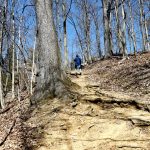MORGANTOWN — WVU students and alumni from the School of Design and Community Development will combine talents to design a visionary plan for the WVU Core Arboretum, a 91-acre natural area between Monongahela Boulevard and Monongahela River.
During the WVU landscape architecture program annual design charrette, a team of designers will work quickly to address problems identified through their own analysis and by various stakeholders, as well as develop designs for key elements of a proposed Core Arboretum master plan.
The outdoor facility, managed by the Department of Biology, includes three miles of foot trails and is used for education, research and recreation.The event is led by a collective team consisting primarily of third-year landscape architecture majors and current practitioners who are also graduates of the program. And, unlike previous years, multiple programs in the School of Design and Community Development will also participate — agricultural education and extension, design studies and interior design.
“One of the primary learning outcomes for our students is to reinforce quick design thinking and the skills necessary for professional-level experiences,” said Vaike Haas, assistant professor of landscape architecture and coordinator of the event. “This is the chance to get some visuals and ideas generated that can serve as a dialogue point that starts conversations about what the Arboretum could be. We are not planning what it is going to be; we’re just giving some ideas focused on its potential.”
Haas and Anna Withrow, visiting lecturer of landscape architecture and co-coordinator of the charrette, have been working in collaboration with Zach Fowler, director of the Core Arboretum and clinical assistant professor in the Eberly College of Arts and Sciences.
Many of their ideas will address issues related to storm water, stream erosion and trail slopes, while taking other factors into consideration, such as vegetation and circulation.
Students are conducting a thorough analysis and developing a trail plan that will determine which sections of the trail are usable and which ones need to be rerouted.
One major component of the proposed plan will be the development of a new trail, the Core Arboretum Universal Access Trail, which would use a section of university property along the Monongahela River.
“We always want to improve alternative transportation, especially in an area like ours where we have so many stresses on traditional forms of transportation vehicles,” said Traci Knabenshue, director of WVU Sustainability. “Given the location of the Core Arboretum and river, which creates an obvious barrier, an access trail could be a great way to increase transportation venues — pedestrian or biking for students, staff and community members — and increase access for users with disabilities.”
In addition to exposing students to a professional-level experience, the charrette provides a unique opportunity for returning alumni.
“It’s exciting to recruit alumni mentors and even more exciting to see our alumni use this as a way to recruit for their companies,” Haas said. “The event has become an effective internship and job placement tool for our students.”
This year’s participating alumni are Nathan Greene, landscape architect and aquatic resources restoration specialist, Allstar Ecology (Fairmont); Sean Michael, department head and professor, Landscape Architecture and Environmental Planning Department, Utah State University (Logan, Utah); Scott Scarfone, landscape architect, Kimley-Horn and Associates (Baltimore, Md.); and John Tschiderer, senior vice president, Federal Realty Investment Trust (Rockville, Md.).
A public input session will be from 9:30 a.m.-12:30 p.m. April 3, during which students will present their designs. It will be held in room 4004 in the Agricultural Sciences Building (333 Evansdale Drive, Morgantown). The public is invited to attend; to RSVP or to request more information, contact Anna Withrow, at Anna.Withrow@mail.wvu.edu.











